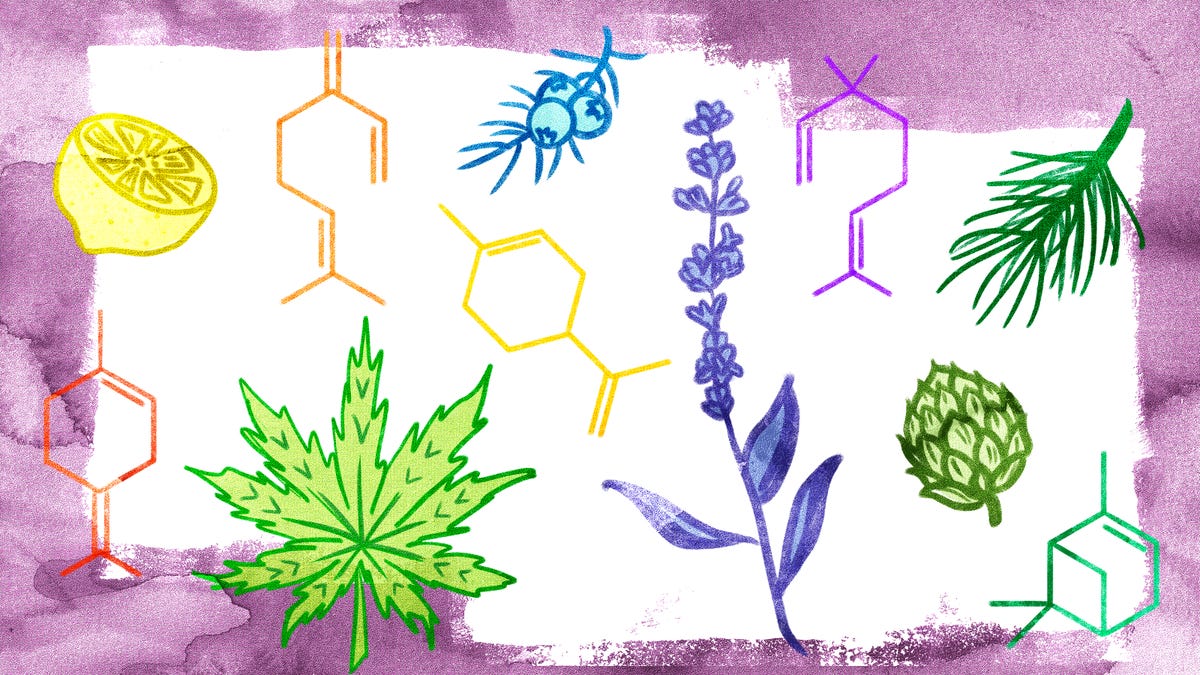What Are 'Terpenes' in Weed (and Why Do They Matter)?
By the time you’ve gotten into using cannabis to the point that you’ve started to pay attention to what’s printed on the labels of your products or have found a budtender whose advice you trust, you’ll probably have come...

By the time you’ve gotten into using cannabis to the point that you’ve started to pay attention to what’s printed on the labels of your products or have found a budtender whose advice you trust, you’ll probably have come across the term “terpenes” more than once. But what are they, and why should you care about them when selecting your stash?
Lest you think that terpenes—“terps’’ in canna-jargon—are just a weed thing, you should know they they are the aromatic chemicals found in almost…everything. Lavender and rose scent? Terpenes. Gasoline and turpentine? Also terpenes. From a minty toothpaste in the morning to a fine glass of red wine in the evening, terps are the chemicals that lead your nose on a journey. People can be terp fanatics and not even know it—both naturally occurring scents and engineered aromas get their power from terpenes, which are found in foods, beverages, body care products, and more.
As far as weed is concerned, terpenes are the identifiable aromatic compounds that tell the consumer about a product’s overall flavor profile. Cannabis strains are less finite than other plants like orange and lemon; every cultivar smells similar and yet different at the same time. Legal, packaged, cannabis goods tend to test for terps to give people a clue as to what to expect in the bag.
Why do the terpenes in cannabis matter?
In cannabis, terpenes can tweak the outcome, though the most overused line in weed writing applies here: We don’t yet know why the “entourage effect” gets you super baked, but it involves hundreds of yet-to-be-mapped components, with terpenes chief among them (after, of course, powerhouse cannabinoids like THC and CBD).
Terpenes interact with the myriad of compounds in cannabis to modify how your body and brain react to it, and those effects are also individually determined. Strains and cultivars’ reputations are staked on their terpene profiles, and an expert cannaseur can identify them by scent alone—kind of like a wine taster or perfume chemist.
These chemicals come into play in discussions of various strains or cultivars, their flowers’ varied aromas, and their concentrates. Cannabis fanatics tend to also be terpene fanatics, chasing down rare combinations of aromas in search of their best high yet—though that means different things for different users.
How terpenes are talked about in the cannabis market
While strain-specific products contain the same terps as the plant they were derived from, many of them can have additional terpenes added. Whether you like how those products make you feel, or how they taste, will determine your preferences.
A popular strain-specific product—Lost Farm by Kiva’s Fruit Chews—taste just like the weed Starbursts I used to make at home for discrete medicating, with a more nuanced weed flavor. A representative for the company told me via email that the stronger plant taste was intentional, because it means the edible better matches the full-spectrum effects of smoking flower. “They provide a full-spectrum, true-to-the-plant high that is noticeably richer, brighter, and more complex than your average edible,” the rep wrote. “It’s the kind of full-sensory experience that is usually exclusively available to smokers.”
Whether your experience matches that admittedly subjective marketing language, some users [me] report needing less THC to “feel it” after eating one of these full-spectrum chews. I suspect that it’s not only the entourage effect happening in my mouth, but the way the chew dissolves rather than getting swallowed and processed by the digestive system.
The inclusion of strain specific, terpene-packed live resin fundamentally changes the way edibles are made. As the Kiva’s rep noted, “making full-spectrum edibles is [challenging]...Prior to infusion, we de-carb the live resin with a lot of care and at such a minimal degree [temperature-wise] in order to keep the delicate terpenes, cannabinoids, and flavors in the finished product.“
How to shop for terpenes in your weed
Terpenes are tasty, but for OG weed fans they are tastiest in their flower form. If you are a newb, the way terpenes are talked about can seem daunting, but as you get more comfortable with cultivars, you will be able to identify your favorites. Many budtenders have told me to “follow my nose” over the years, which means if you like the smell, you might also like the effects.
Growing conditions, along with how the product is treated, can also determine the terpene quantity and quality. Cannabis producer Stone Road founder and CEO Lex Corwin said his company uses its knowledge of how terpenes behave on their farm to help guide the final outcome.
Corwin chooses cultivars based on his consumer profile. “Our customers love fruity and sour strains over more traditionally gassy ones,” he said. “Being a high elevation farm, it’s important that we choose the right genetics that thrive in our mini ecosystem.”
Leaning on signature expressions that do well in their habitat is the skill people lend to craftspeople working in fine foods and wine, and is still a new concept to the average cannabis consumer. “We aim to make products that are delicious and fresh and have found that the most popular terpenes our customers seek out are Terpinolene (fruity and flowery), Limonene (citrus and minty) and Pinene (pine, herbal, earthy),” Corwin said.
Since there’s a flavor for everyone, brands that don’t chase the potency preoccupied consumer who only cares about THC contentcan cater to more discerning buyers.
“People definitely care about the THC figures,” Corwin admitted, “but hopefully that trend is subsiding a little. Once people can identify a terpene with a feeling they are more likely to seek out flower with similar profiles.”
If you want to stay ahead of weed trends and find products that fit your particular “tastes” when it comes to getting buzzed, start by following your nose.

 Fransebas
Fransebas 































